I would like to express my appreciation to several people who helped in the preparation of this study: R. Wayne Shoaf, Archivist at the Arnold Schoenberg Institute, gave generous assistance at several stages; Nuria Schoenberg-Nono supplied valuable information on the paintings; Lawrence Schoenberg, President of Belmont Music Publishers, kindly arranged my access to the paintings; and finally my thanks go to Porter Aichele, Art Department Head at University of North Carolina, Greensboro, and Linda Klinger, Franklin and Marshall College, for their perceptive comments on artistic aspects.
Arnold Schoenberg's musical innovations in the years 1908 to 1912 that initiated his atonal period have long been recognized, but it is only relatively recently that art historians have come to appreciate the significance of a number of art works he completed during the same period.1 This was a time of intense activity for Schoenberg both as a composer and as a painter. During these important musical years, he also contributed works to three art exhibitions and even hoped to obtain some commissions as a portrait painter. Wassily Kandinsky tried to persuade him to participate in a fourth exhibition in 1912, but Schoenberg declined. By early 1912, he had begun to turn away from painting as a major outlet and to focus his full attention once again on his musical compositions.
The art works are of interest not only in their own right, but also for the parallels that can be drawn between his musical and his artistic output during these years. His art was never intended as a visual representation of his music. Nonetheless, the paintings and the music arose from the same inner need for expression, and they show some significant similarities as well as some striking differences in approach. Both musicologists and art historians use the term "expressionistic" in describing his works at this time, and some of the similarities are the obvious ones associated with the expressionist movement in general. Other connections between the music and art, however, are particular to Schoenberg and relate to his individual artistic views.
Some brief background information is in order before we turn to a direct comparison of the music and art. Musically, the years 1908-1912 marked the introduction of atonality in Schoenberg's style. Our study will draw on the eight atonal works that were finished or substantially completed during this period: the operas, Erwartung (Op. 17) and Die glückliche Hand (Op. 18); a set of fifteen songs with piano accompaniment, Das Buch der hängenden Gärten (Op. 15); the song Herzgewächse with chamber accompaniment (Op. 20); Pierrot lunaire for voice and chamber ensemble (Op. 21); an orchestral work, Five Pieces for Orchestra (Op. 16); and two sets of piano pieces, Three Piano Pieces (Op. 11) and Six Little Piano Pieces (Op. 19).
It is harder to date exactly the visual art created between 1908 and 1912 than it is the music. He rarely signed or dated his art, and developmental patterns have been difficult to trace. The oil paintings, however, stand out as a separate category from the watercolors, pastels, and numerous works for pen, pencil, crayon, graphite, and charcoal. He valued the paintings above his other art,2 and seems to have produced most of them in a spurt of activity sometime between 1907 and 1912.3 He was not simply a recreational painter, but approached painting with the same seriousness that he did musical composition. In a later interview with Halsey Stevens, he confirmed that painting "was the same to me as making music."4
For us, then, the oil paintings will provide the best artistic focus, given the seriousness with which Schoenberg approached them and the likelihood that most of them originated in the approximate time period with which we are concerned. The most recent catalogue (Arnold Schönberg; Das bildernische Werk) identifies seventy-six oil paintings.5 These include self-portraits, portraits of others, outdoor and landscape views, set designs, caricatures, and a number of striking "visions and gazes" that explore an inner rather than an outer world. In the discussion to follow, we will identify the art works by the title, number, and page used in Arnold Schönberg: Das bildnerische Werk (see complete reference in footnote 1). For the reader's convenience, several of the paintings discussed in this article are reproduced as Figures 1-12.
There are some hypotheses about why Schoenberg turned with such intensity to painting around 1907. Jelena Hahl-Koch connects Schoenberg's involvement in painting with his development of the atonal style in music. She notes that artists experiencing a point of crisis in one art may turn to a second area; and she cites among several examples those of Kandinsky and Kokoschka, both of whom began to write drama at transitional stages in their artistic development. She suggests that expression may come more easily in a medium in which the artist was not thoroughly schooled.6
Many writers relate Schoenberg's interest in visual art at this time to a catastrophic personal situation that reached its peak in 1908. Schoenberg depended on a loyal coterie of close friends who supported him emotionally and artistically in the face of what was often severe condemnation of his music by both the public and the critics. In the summer of 1908, he found himself betrayed by two members of this inner circle when his wife Mathilde deserted him and their two children for the painter Richard Gerstl, whom Schoenberg believed to be a trusted friend. The horror was compounded when in November of 1908 the 25-year-old Gerstl committed suicide by simultaneously stabbing and hanging himself. One writer sees Schoenberg's self-portraits as a way of dealing with depression in connection with this experience, and he notes that Schoenberg's portrayal of the eyes in the self portraits shows a striking similarity to the staring eyes in paintings of patients suffering from depression.7 Another possibility, certainly, is that the art helped exorcize his anger with the critics;8 he created some harsh caricatures in Critic I (169, p. 275), Critic II (170, p. 277) and Art Patron (171, p. 279). Yet another impetus to his painting that should not be discounted was the hope of supplementing his income, which was particularly meager at this time.
Schoenberg was essentially self-taught in painting, just as in music. He worked with the painter Richard Gerstl for a short time informally, just as he had studied music with Zemlinsky for about a year. For the most part, Schoenberg was able to assimilate basic concepts without adopting the mannerisms or the style of his mentors. Thus, although there are some similarities of technique in a few paintings, he does not take over Gerstl's general style;9 and the same may be said of his music and its connection with Zemlinsky.10 There is, however, an important difference in Schoenberg's practice of the two arts. In music, he was a self-trained professional—he had studied the great masters in depth and modelled his own compositions on what he found best in their work.11 In art, he undertook no such systematic study and always thought of himself as an amateur.12
It is important at this point to say a word about the manner in which Schoenberg's art and music will be compared. One approach would be to focus on the art and music that deal with the same subject matter, but only three of the paintings can be connected to specific musical works.13 Hence, similarity of subject matter will only apply in a general sense, such as the autobiographical focus that is found in both his art and music. There are some additional elements, however, that show useful parallels in Schoenberg's case, such as his treatment of rhythm, for example. As each of these specific parameters is discussed below, the criteria by which a single element such as rhythm is compared in the two different visual and aural mediums will be carefully clarified.
We turn now to an examination of his paintings, and what is immediately apparent is the strong autobiographical focus, a feature that Schoenberg shares with other expressionist painters such as Egon Schiele and Oskar Kokoschka. In Schoenberg's art as a whole, self-portraits account for over one-quarter of his output. Among the oil paintings alone, the proportion is not that high, if we consider only those works specifically titled Self-Portrait. However, Schoenberg also painted a number of oils called Vision or Gaze, some of which have a strong connection to his self portraits. Consider Figure l Green Self-Portrait (3, p. 169), Figure 2 Self-Portrait (74, p. 208), and Figure 3 Red Gaze (75, p. 207), all dated 1910 in Schoenberg's hand.14
Fig. 1
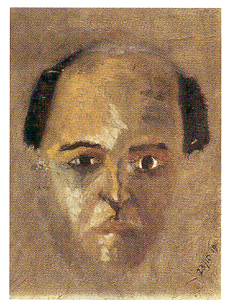
3. Green Self-Portrait, 1910, p. 169
Oil on wood, 33 X 24 cm
Fig. 2
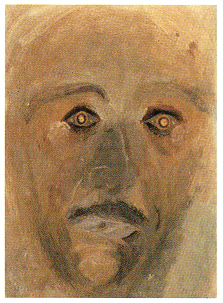
74. Self-Portrait, 1910, p. 208
Oil on canvas, 32 X 20 cm
Fig. 3
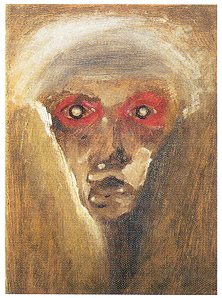
75. Red Gaze, 1910, p. 207
Oil on cardboard, 32 X 25 cm
Fig. 4
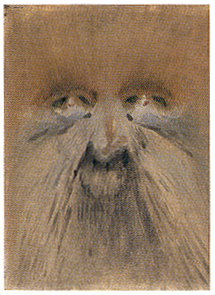
84. Tears, p. 205
Oil on canvas, 29 X 23 cm
Figure 2 was originally titled Vision when it appeared in the first exhibition of the Blaue Reiter in 1911, and it does not bear a close resemblance to the other self-portraits. However, in a letter giving the painting to Leopold Stokowski, Schoenberg refers to it as a self portrait (74, p. 369). Figure 3 Red Gaze becomes easier to see as a self-portrait, once the viewer is aware of the intermediary step that Figure 2 represents. One writer sees the unusual Figure 4 Tears (84, p. 205) and the Vision of Christ (83, p. 203) as self-referential in their portrayal of hurt and humiliation.15 Hence, the autobiographical aspect is not limited simply to the obvious self-portraits, but extends to other works as well. I would add at least seven visions and gazes that contain elements of self-portraiture to the list of autobiographical paintings.16
The art also reflects another characteristic that Schoenberg shares with several expressionist painters—that of alienation. Returning to Figure 1 Green Self-Portrait, we find the painted space dominated by a massive head with eyes that pinion the viewer. The head is disembodied and floats in a nebulous background, not necessarily of this world. The color is a sickly, unnatural green. Most of the self-portraits show a similar detachment from the world, achieved through the emphasis on staring eyes in a large head against a blank or non-specific background. Several of the visions and gazes also duplicate this treatment.
Schoenberg's portraits of others stand completely apart from his self-portraits. It is as though he saw himself in an entirely different way than he saw others. The portraits of others often provide a suggestion, if not a detailed reference, to a room setting, as in Figure 5 Wife of the composer Alban Berg (101, p. 245).17
Fig. 5
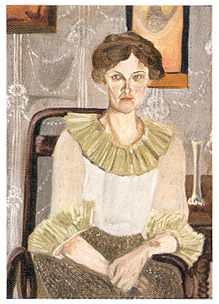
101. Wife of the Composer Alban Berg, 1910, p. 245
Oil on canvas, 100 X 74 cm
Several show the figure from the waist up or even lower, a feature that gives a sense of corporeality and occurs only twice among the self-portraits (4, p. 141 and 10, p. 137). Schoenberg often stated that his creativity was the product of inner necessity, the need to express the inner world rather than the visual world. In this sense, the portraiture of others relates to the visual world, while the self-portraits (and some of the visions and gazes) reflect the inner world and its isolation by means of the vague backgrounds and the emphasis on the eyes that Schoenberg saw as a mirror of the soul.
The same elements of self-focus and alienation are prominent at this time in Schoenberg's musical works with text. The most obvious example is Die glückliche Hand, for which Schoenberg wrote the libretto as well as the music. The drama portrays the suffering of a great artist whose contributions were unappreciated by the world at large. Erwartung concerns infidelity, loss, and death, which also give it autobiographical overtones, even though Schoenberg himself did not write the text.18 For Pierrot lunaire Schoenberg selected 2l poems from a total of 50 written by Albert Giraud; and several of these can be seen as self-referential, especially those that reflect martyrdom, persecution, or horror. The poems of Das Buch der hängenden Gärten by Stefan George tell of the painful loss of a beloved for whom the poet felt a consuming passion. Of all the vocal works, Herzgewächse by Maurice Maeterlinck is the only one that avoids ominous overtones. The tired, unhappy poet takes hope from seeing a single lily rise above the surrounding, dreary vegetation.19
The term "nightmarish" is frequently used to describe the impact of Erwartung, Die glückliche Hand, and Pierrot lunaire. Musically, the extreme dissonance, the lack of tonal center in these works, and especially the unusual sprechstimme technique used in Pierrot lunaire and Die glückliche Hand make this term apt. The description is appropriate to a number of the paintings as well. In Figures 6 and 7, for example, he achieves a nightmare quality through unsettling distortions of the face.
Fig. 6
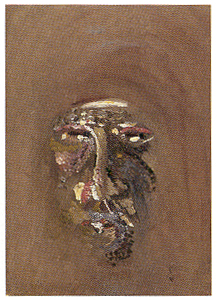
86. Gaze, p. 210
Oil on cardboard, 23 X 18 cm
Fig. 7
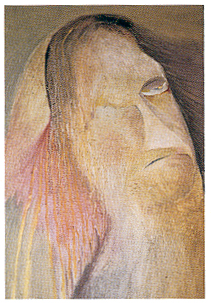
89. Vision, p. 224
Oil on canvas, 59 X 46 cm
In Figure 6 Gaze (86, p. 210) he scarifies and fragments the countenance. In Figure 7 Vision (89, p. 224) he disfigures it with a disturbing melting effect.20 In several other works he gives the face shocking animal qualities, as in Figure 4 Tears (84, p. 205).21 Even his landscapes can impart horror. Night Landscape (203, p. 297) is almost entirely black and uses heavy impasto (a thick, rough application of oil to the canvas). The viewer only gradually discerns through the darkness, the figure of a woman placed stiffly and angularly on the lower right-hand side of the painting.22
The similar qualities described thus far in Schoenberg's art and music—self-focus, alienation, and horror—are ones that are associated with the expressionist movement in general. We go now to some further parallels between the art and music that are individual to Schoenberg.
First, there is the concept of design or balance as Schoenberg conceives it in the two arts. Musically, passages of exact repetition that provide important guideposts in determining the organization of a work are rare in the atonal period. When Schoenberg wishes to provide a sense of recall, he brings back some elements, but alters others by modifying the material melodically, adjusting it rhythmically, or adding musical lines to the texture (as the example in the following paragraph will show). Typically, also, the recalls are shortened relative to the original statement. These sections of varied repetition and shortened recall appear in places that give a slight imbalance to the overall design. In other words, the repetition is not exact, nor does its placement exactly balance the original. Thus, we can speak of a near symmetry of design, as opposed to an exact symmetry or an asymmetry.
An example will make this usage clear. In Pierrot lunaire at the instrumental close of No. 13 "Beheading," the flute duplicates exactly nine measures of a 26-measure melody that it originally introduced in No.7 "The Sick Moon." The duplication from No. 7 is selective, involving mm.1-6, 14, and 22-23 (five newly composed measures complete No. 13). The sense of recall is strong in this case since such an extended duplication does not occur anywhere else in the cycle. Additional alterations in No. 13 relative to No. 7 include added instruments, a partial recurrence of the vocal part in the bass clarinet and 'cello lines, and a reduction in length from twenty-six measures in No. 7 to fourteen measures at the close of No. 13. The placement of the recall is similar, but not exactly so, to the first appearance. The song cycle as a whole is divided into three sets of seven songs each. The material first appears in the last song of the first set, and its return is in the next-to-last song of the second set. Thus, the recall almost signals the close of both major divisions, but not quite—a good example of near symmetry.23
His art reflects a similar approach. A casual glance through the figures illustrating this discussion (Nos. 1-12) shows a firm grasp of balance without the precision of exact symmetry or the serious imbalance of asymmetry. Figure 8 Landscape (199, p. 304) is a good illustration of near symmetry in the paintings.
Fig. 8
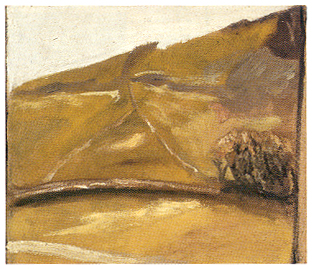
199. Landscape, p. 304
Oil on canvas, 23 X 27 cm
The sketch below represents a linear reconstruction that exposes the prominent shapes of the painting. The dotted lines on the right show small patches of color that fit on the basic linear structure. All the colors have a muddy quality, so the variety of hues on the right does not challenge the overall yellowish green that appears in all the unmarked sections of the sketch.
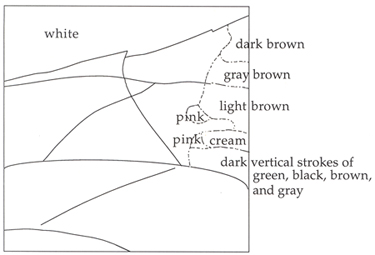
A basic triangle, with an inverted triangle at its top, provides the central focus. It is somewhat off-center and is anchored at top and bottom by two roughly parallel lines that divide the painting into three approximately equivalent sections. Vector shapes that are triangular in some instances and turn into trapezoids in others intersect in varying ways. The freely drawn geometric figures vary considerably in size and shape but combine to form a satisfying near-symmetrical whole.
That Schoenberg appreciated the significance of proportion in both arts is clear: "I had a good sense of relations, of space relations, of measurements. I was able to divide, let us say, a line rather correctly in three, four, five, six, seven, even eleven parts, and they were quite near the real division . . . this sense of measurement . . . is one of the capacities of a composer, of an artist."24 At this time for Schoenberg, however, exact duplication was anathema. Rather, he delineated the proportions of his design through repetition that was varied in content and placement. The result was a near symmetry in both arts as opposed to exact symmetry or true asymmetry.
A second element that functions in both arts is that of rhythm. In general, Schoenberg's atonal music does not reflect a strong or regular sense of pulse; in his writings about music, in fact, he refers explicitly to his "disregard for the 'strong' beat of the measure."25 In fact, he had a systematic means of deemphasizing the first beats of measures by using a rest, tying a note over the measure, or writing lines with melodic contours or phrasing that extended over the barline.26 In addition, several of his atonal works introduce frequently changing meters or tempos which reduce even further any effect of rhythmic regularity.27 There is rhythmic organization, but it is a subtle one that does not depend on obvious downbeats or a regular strong pulse.28
There are additional ways in music of deemphasizing rhythm and movement such as the use of ostinatos or pedal tones. Ostinatos can either reinforce rhythm, as in a motor ostinato, or inhibit it, as in a static ostinato.29 The former employs a fast tempo, strong dynamics and accents, sometimes a crescendo or accelerando, and enough time for the effect to build up; the result is an intensified rhythm. The latter lacks accents, is short, and if it starts fast and at a high dynamic level, it will taper off to a slower tempo and lower dynamic level. The static ostinato holds back movement and often appears at cadential points in the atonal music. It is this latter kind of ostinato that predominates in the works between 1908 and 1912.30 Several factors, then, contribute to the lack of rhythmic drive and forward motion in Schoenberg's atonal music—the avoidance of a regular pulse, the lack of accents on first beats, the continuous changing of meters and tempos, and the frequent use of static ostinatos.
One of the most direct ways to express rhythm in painting is through the repetition of lines, colors, or forms. A sense of motion in painting can also come from the subject matter itself, or it may result from techniques such as the use of individualized brush strokes, heavy repeated impasto (rough, thick strokes), or a linear directionality, such as strong diagonal lines. Again, a look at the illustrations for this article (Figures 1-12, which are fairly typical) elicits neither a strong sense of rhythm nor of motion from the standpoint of either subject matter or treatment. There is a static quality to the portraits, and among the visions and landscapes most of the diagonals are overpowered by strong horizontals and verticals—the exception, Figure 10 Vision (91, p. 216) will be discussed below. Linear use is minimal, with forms conveyed by color rather than line. Even the expression of an emotion as strong as Hatred in Figure 9 (93, p. 227) produces an anger that seems frozen.
Fig. 9
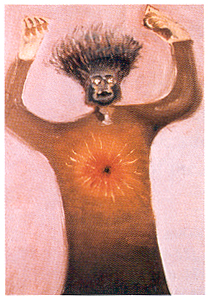
93. Hatred, p. 227
Oil on canvas, 43 X 30.5 cm
Fig. 10
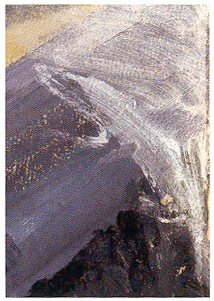
91. Vision, p. 216
Oil on canvas, 25 X 16 cm
The prominent shapes such as the eyes, the arms, and the central symbol on the chest are all circular and suggest a rage that is more impotent than effective. Typically in Schoenberg's paintings, the brush strokes are blended rather than discrete, and the use of thick impasto is rare. Rhythm and forward motion, then, are no more characteristic of the paintings than they are of the music.
Another intriguing parallelism lies in the use of pictorial imagery in his art and music. In his writings Schoenberg spoke out against literal representation in music.31 He claimed to be opposed to the use of word painting. He believed music should reflect the inner, more general sense of the text, rather than superficially portray individual words by musical means. What becomes evident, however, on close examination of the music of this period is that there are, in fact, numerous examples of obvious word painting. In many cases where there is a textual reference to "up" or "down," this direction is reflected in the music; and some of these examples are anything but modest. In Herzgewächse on line 11, "In its unchanging ascension," the soprano melody moves up by leaps over two octaves in four quarter notes and a half note. These are note values which have not been typical in the vocal line and call strong attention to the passage. Similarly, for the text "Slowly sinks the sun," of No. 14 "The Crosses" in Pierrot lunaire, two quarter notes illustrate "slowly" (surrounded by faster note values), and a descending line portrays "sinks the sun." There are numerous further examples.32 It seems clear that while Schoenberg's intent may have been for his music to reflect the inner meaning of the text in a larger sense than simple word painting provides, nonetheless, word painting can be, and often is, a by-product of the process.
A parallel situation occurs in the paintings, although the evidence can be better seen in the original paintings than in the reproductions. In Figure 11 Thinking (88, p. 217) there is a spot of gold at the top of the head that seems to symbolize the concept of thinking.
Fig. 11
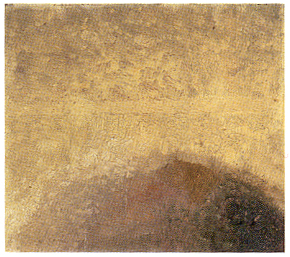
88. Thinking, p. 217
Oil on cardboard, 22 X 25 cm
The same touch of gold appears at the top of Schoenberg's head in Figure 1 Green Self-Portrait (hardly visible, unfortunately, in the illustration). A spot of bright yellow also marks the top of Schoenberg's head in the otherwise somber Self-Portrait (4, p. 141). The connection of gold with the head and the process of thinking provides a striking parallel to word painting in music and fits well with Schoenberg's own value system. Although he believed strongly in the role of intuition in the creative process, he also had a great respect for logical reasoning. He described once how relieved he was to discover after twenty years a logical connection between the two main themes of his first Chamber Symphony, for he had been worried about the apparent absence of this link ever since he composed the work.33 Literal references, then, mark both the music and the painting.
Another potential point of comparison between Schoenberg's music and art relates to athematicism in music and abstraction in painting. The term "athematic" refers to pieces that lack a recurring motive or melody, and abstract paintings are those without a distinct representational subject. Both could be thought of as "works lacking clear subject matter." Total abstraction in painting was as radical a step in painting at this time as was athematicism in music. Most analysts of Schoenberg's music argue that at least three works are "athematic": Op. 11 No. 3 for piano, Op. 16 No. 5 for orchestra, and Erwartung.34
Examples of abstraction in the art, however, present a problem. In discussions of abstraction in painting, two works by Schoenberg are usually singled out—Figure 10 Vision (91, p. 216) and Figure 11 Thinking (88, p. 217). Vision is unusual in Schoenberg's output, for it is constructed entirely on the diagonal with multicolored bands. Freitag catalogues this work among the unfinished landscapes; but it is uncharacteristic relative to the other landscapes and an unlikely nature scene. Nuria Schoenberg-Nono has indicated that this example was separate from the other paintings found in her father's legacy and had neither frame nor title. The edges are damaged, and she believes it may simply be a scrap of cardboard on which he was trying out different colors. To claim it as a water-shed example of total abstraction is clearly risky. In the second work, Figure 11 Thinking, Schoenberg is portraying an abstract concept, which is innovative in itself. Once the title is known, however, it is not hard for viewers to read representational imagery into it. The arc at the bottom of the painting looks like a head, and the concentration of gold at the summit of the arc could easily represent the process of thinking.35 In view of Schoenberg's autobiographical bias, the dark portion at the lower right could well be his own hair, and the pale section of the arc on the left, his markedly high forehead. That the imagery is open to identification does not diminish the significance of painting an abstract concept, but it is important not to overstate Schoenberg's artistic achievements in the area of abstraction. This particular comparison, then, is best avoided.
In two areas Schoenberg's usage in the two arts differs dramatically—the first concerns complexity. Although the musical works in this period are short relative to those composed earlier and later, the textures within them can be highly complex. The orchestra pieces in particular make use of multiple simultaneous contrapuntal strands—the first movement of Op. 16, for example, contains numerous canonic passages, with entrances sometimes only a beat apart.36 Similarly, sections of Pierrot lunaire employ a variety of contrapuntal techniques (fugue, canon in diminution, retrograde, and inversion among others). This is also the period in which Schoenberg devised his notational system of H for the main theme and N for the secondary theme to help clarify the important lines in his intricate contrapuntal web.
In contrast, complexity and attention to detail do not characterize the paintings. Usually, there is a single dominating focus that immediately strikes the viewer, and the work does not require lengthy study to unravel its meaning. In the portraits and some of the visions, the emphasis is either on the face or the eyes. Most of the other visions and landscapes also present a single uncomplicated scene or concept. In describing Schoenberg's paintings, Kandinsky applauded the "renunciation of the superfluous" and avoidance of ornamentation and detail.37 Kandinsky saw Schoenberg's focus on the essential as a valuable expression of subjective feeling.
A close look at one of the landscapes will show Schoenberg's typical reductive approach. Figure 8 Landscape, which we have already discussed above, reproduces a general rather than a site-specific nature study. A muddy yellow dominates the scene, with few gradations to suggest depth. On the lower right-hand side, a cluster of dark vertical strokes with some pink at the top suggests foliage; a small dark section at the top right could be rock. Schoenberg avoids much modelling or detail, and the viewer has no sense of scale. The greenery at the lower right looks like a stand of trees at first, but the faint pink at the top suggests flowers, or at least a flowering bush. The uncertainty of the foliage reinforces the overall ambiguity. How big are these hills, and is the viewer close or distant? Schoenberg himself was uncomfortable with his landscapes and his portraits of others and referred to them as "five-finger exercises," a means of developing his skill. Nonetheless, painters such as Kandinsky and Albert Paris von Gütersloh, who arranged for Schoenberg's final exhibition in Budapest, saw this "reductive" treatment in a positive way.38
There is one notable exception to Schoenberg's typical landscape treatment. Figure 12 Garden in Mödling (195, p. 291), is a site-specific work that shows considerable detail and a clear sense of scale. It is thought to be an early work from before 1908 and to strongly reflect Gerstl's influence.39
Fig. 12
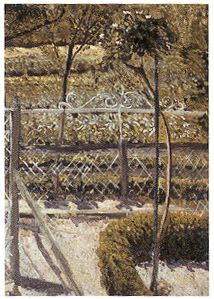
195. Garden in Mödling, p. 291
Oil on cardboard, 71 X 49 cm
What is significant, however, is that Schoenberg, at least on this one early occasion, conceived of a landscape in detailed and naturalistic terms. Subsequently he decided against this style in favor of more abstract scenes, which constitute the majority of the landscapes. The style choice was a conscious one. The music and art, then, stand apart on the matter of complexity and detail. The paintings do not need minute and careful examination—their subject matter and treatment are simple and direct. In contrast, the music challenges the listener with its intricacy, and its study uncovers much richness.
The second element that differs in Schoenberg's practice of the two arts involves the use of color. In artistic terms, color concerns the basic hue (blue, green), its shade (degree of lightness or darkness), and its intensity (brilliant versus weak). In music, color refers to tone color, the timbre of an instrument, which will vary according to the type of instrument and range that is used. Color in art makes a good parallel to tone color in music. In fact, Kandinsky even went so far as to assign particular colors to different instruments and ranges. For example, he associated light blue with the flute, a darker blue with the 'cello, a blue that was darker still with the double bass, and the darkest blue of all with the organ.40 It is doubtful, however, that Schoenberg made such specific identifications.41
That tone color in music had considerable significance for Schoenberg is clear from his development of Klangfarbenmelodie, a concept whereby instrumental changes assume the status of melody and can determine the course of the composition. Further, the kinds of instrumental timbres that he favored were contrasting ones that brought out the clarity of the lines. "Similar colours, particularly similar tone-colours, melt too easily into one another, forming chords, and it is then certainly harder to follow the construction of the texture."42 In the orchestra movements he individualizes the tone quality of the instruments by asking them to play in unusual registers and by drawing on individual soloists from every section including the double bass.43 Consistently in his scores, he is after new and special color effects that promote the individuality of the lines.
His approach to painting is exactly the opposite, for he avoids sharp contrast. A number of his oils emphasize a single overall hue, such as the self-portraits named for a color, Blue Self-Portrait (1, p. 131) and Green Self-Portrait (3, p. 169) or the gazes, Red Gaze (75, p. 207 and 77, p. 214) and Blue Gaze (90, p. 225). Many of the landscapes also emphasize a single overriding shade—the dull yellow of Landscape (199, p. 304), or the gray-beige of Landscape (201, p. 303). Even Figure 12 Garden in Mödling, which could be a riot of brilliant color, is an overall green and gray with only a few bright accents. When he does use prominent color blocks, as in some of his portraits of others, the colors tend to be dark and muddy, which minimizes their contrast. One writer suggests that "Schoenberg did not know how to bounce contrasting colors off each other for heightened expressive effect (as Gerstl or any professional artist would), but he did know how, subtly, to tune them to the same pitch."44 Kandinsky also mentions Schoenberg's restrained use of color when referring to a portrait of a woman that showed "only the sickly pink of the dress otherwise no 'colors.'"45 In music, then, Schoenberg sought a clarity of color by using contrast, whereas artistically he avoided bright colors and sharp contrast.
One final point should be considered. Is there any way of connecting the atonality of Schoenberg's music with the style of his paintings? Indeed, some writers have related the dissolution of tonality in music with the dissolution of perspective in art.46 Specifically, they see a parallel between the atonality of the Second Viennese School and the lack of traditional perspective in such painters as Cézanne, Klee, and Kandinsky. As the argument goes, traditional harmony in music relates to the third dimension in art, and the artist who eliminates perspective or the third dimension in painting is similar to the composer who through atonality and the avoidance of progressive harmony removes the third dimension in music. While this analogy certainly has merit, it should be applied to Schoenberg in the painting area somewhat cautiously. Some of his paintings exhibit a high level of ability; but there are others that have distinct limitations that appear to be related to his inexperience. The lack of perspective in his painting, then, may be more the result of his amateur status than his intent. Any consideration of Schoenberg's lack of perspective in his painting needs to take this point into account.
In the final analysis, then, what can we conclude from these similarities and differences in Schoenberg's practice of the two arts? The general expressionist qualities—autobiographical characteristics, alienation, and horror—that link Schoenberg's practice in the two arts come as no surprise. What is of more interest are the similarities and differences in music and art that are specific to Schoenberg. In the matter of design and balance, certainly a fundamental concept in both arts, Schoenberg shows a preference for near symmetry as opposed to exact symmetry or a strong assymmetry. Rhythm, another basic parameter in music and art, also receives similar treatment in the two mediums. On the other hand, there are major differences in his approach to complexity of texture and color. There is no easy explanation of these differences; we can only speculate. Conceivably, the different treatment he accords these two areas may stem from a need for psychic balance relative to these parameters. While Schoenberg's fundamental concepts of organization and rhythm remained essentially consistent in his practice of the two arts, his approach to color and complexity stood in opposition, perhaps the result of his instinctive need to strike an inner balance.
1A number of fine studies are now available. Most recent and most complete is the bilingual catalogue of all Schoenberg's visual art: Arnold Schönberg: Das bildnerische Werk (Arnold Schoenberg: Paintings and Drawings), edited by Thomas Zaunschirm (Klagenfurt: Ritter Verlag, 1991). It reproduces all the works in color and contains valuable articles and information. Another outstanding treatment is that of Jane Kallir's Arnold Schoenberg's Vienna (New York: Galerie St. Etienne and Rizzoli International Pubs., 1984), which accompanied an exhibition of 66 art works by Schoenberg, Gerstl, Klimt, Kokoschka, and Schiele. Other significant contributions to the study of Schoenberg's art include the work of Eberhard Freitag—both his book, Arnold Schönberg in Selbstzeugnissen und Bilddokumenten (Reinbek bei Hamburg: Rowohlt, 1973), and his dissertation, "Schönberg als Maler" (Westfälischen Wilhelms Universität zu Münster, 1973). Much valuable material also appears in Jelena Hahl-Koch's Arnold Schoenberg, Wassily Kandinsky; Letters, Pictures and Documents, translated by John Crawford (London and Boston: Faber and Faber, 1984). Additional important information can be found in an issue of the Journal of the Arnold Schoenberg Institute, Vol. II, No. 3 (June, l978), 185-231, that is devoted entirely to "Schoenberg as Artist" and contains an inventory of his works as well as a number of articles.
2Kallir notes the care Schoenberg took of them relative to the careless treatment of the drawings; in fact, he put an even higher monetary value on some of his paintings than on his autograph of Pierrot lunaire (op. cit., pp. 43 and 62). She views his work after 1912 and that in other media as doodling. Freitag, too, discerns a casualness in the later drawings and watercolors that contrasts with the intensity of the earlier visions and fantasies ("Schönberg als Maler," op. cit., p. 12).
3Art historians differ about the precise period of his intense interest in painting, but do not stray beyond the years 1906/7 and 1912 as the outside limits. Freitag gives compelling evidence for the years 1907-1910. He had access to a draft of a biography of Schoenberg that Egon Wellesz was writing. In it, Wellesz claimed the years between 1907 and 1910 were those in which Schoenberg was most active as a painter. Schoenberg had pencilled in corrections elsewhere in the manuscript, but left that section untouched ("Schönberg als Maler," op. cit., p. 86, footnote 3). The close of Schoenberg's concentrated involvement in painting seems to come after his move from Vienna to Berlin in the fall of 1911. Further evidence for this appears in a letter dated December 5, 1911, that he wrote to Alban Berg from Berlin. He noted that his work on the Harmonielehre had interfered with his composing and commented, "Perhaps that's why at present I feel no inclination to paint, either." See The Berg-Schoenberg Correspondence: Selected Letters, edited by Juliane Brand, Christopher Hailey and Donald Harris (New York and London: W. W. Norton, 1987), p. 51. Kallir believes he may have begun to recognize his artistic limitations about this time (op. cit., p. 62), and certainly the lack of sales from the Budapest exhibition in early 1912 must have discouraged him.
4Halsey Stevens, "A Conversation with Schoenberg about Painting," Journal of the Arnold Schoenberg Institute, Vol. II, No. 3 (June, 1978), 179.
5Most of these are in the Schoenberg legacy at the Arnold Schoenberg Institute of the University of Southern California and can be seen there. Additionally, a few works were sold, some others given away, and some are lost.
6Hahl-Koch, op. cit., p. 150.
7Peter Gorsen "Arnold Schönberg als Maler der 'Visionen,'" Hochschule für Angewandte Kunst in Wien: Schönberg-Gespräch (May 25, l984), pp. 57-60. Thomas Zaunschirm in "The Painter Arnold Schoenberg," Arnold Schönberg: Das bildnerische Werk, op. cit., pp. 39-41, takes strong exception to viewing the paintings as therapeutic.
8Freitag, "Schönberg als Maler," op. cit., pp. 19-21.
9Gerstl is described as a rebellious, anti-establishment painter at odds with the Academy in Vienna, which he attended only briefly. One critic characterizes a Gerstl painting of the Schoenberg family at this time as an "anarchic swirl of color...with expressive, gestural brush strokes" (Georg Eisler, "Schoenberg as Painter," Journal of the Arnold Schoenberg Institute, Vol. II, No. 3 (June, 1978), p. 174). Eisler also assumes that Schoenberg was familiar with the work of the secessionist painters Kokoschka and Schiele as well as the symbolists Klinger and Stuck. Schoenberg did, of course, have access to numerous new artistic directions through the many art exhibits available in Vienna. He, however, passionately denied any influence of Kokoschka and cites a comment by Gerstl suggesting that Gerstl adopted some of Schoenberg's artistic techniques rather than vice versa. See Arnold Schoenberg, "Malerische Einflüsse," Journal of the Arnold Schoenberg Institute, Vol. II, No. 3 (June, 1978), pp. 237-238.
10Alexander von Zemlinsky, Schoenberg's musical mentor, had been a successful student at the Vienna Conservatory where his compositions had attracted the attention of Brahms. Zemlinsky was thoroughly trained in Viennese classicism, but moved early in the twentieth century towards Wagnerianism and a personal style described as "progressive romantic." His works were well thought of in Vienna, and he served Schoenberg well as an instructor in counterpoint.
11Arnold Schoenberg, "National Music (2)," Style and Idea (repr., California: University of California Press, 1984), pp. 173-174.
12Halsey Stevens, op. cit., p. 179.
13 Two appear to represent set designs for Erwartung (Night Landscape, 194, p. 301, and 203, p. 297), and the other is a portrayal of Mahler's burial (198, p. 290), which is also the subject of the last piano piece of Op. 19. A static quality pervades the burial scene musically as it does the painting, although the tree branches over the grave suggest agitation. There is no effort to reflect the bell-like sounds of the piece in the painting.
14The first four figures in this discussion were chosen to show specifically the progression from a self-portrait that is clearly recognizable as the composer (Figure 1) to an image that appears far removed from such an identification, but may still be self-referential (Figure 4). Figure 1 represents a typical self-portrait in Schoenberg's output. Figure 2 is already less recognizable, but is still a reasonable representation. By Figure 3 the resemblance to Schoenberg is not at all clear, but a similarity of pose and expression link it to the preceding paintings. Figure 4, if it stood alone, would not suggest self-portraiture, but in the context of the other three paintings may indeed be seen as such.
15Peter Gorsen, op. cit., p. 59.
16The recent catalogue (Arnold Schönberg: Das bildnerische Werk) lists fourteen official self portraits among the oil paintings (two of these are in the visions and gazes section73, p. 201, and 74, p. 208). Those I would add from the visions and gazes include 75, p. 207; 76, p. 209; 83, p. 203; 84, p. 205; 85, p. 211; 86, p. 210; and 87, p. 213.
17Some of the blank or unclear backgrounds in the portraits of others come about because the paintings are unfinished. In his dissertation Freitag views as many as eight of these portraits as incomplete.
18He at least influenced the course of the libretto, for Pappenheim's handwritten draft contains numerous cuts and changes in Schoenberg's hand. See Josef Rufer, The Works of Arnold Schoenberg, translated by Dika Newlin (London: Faber and Faber, 1962), p. 34.
19Schoenberg wrote this song after Kandinsky requested a vocal work for the forthcoming issue of the Almanac to be put out by the Blaue Reiter. As Bonnie Hough suggests, the poem was probably selected to reflect the positive philosophical message of the Blaue Reiter movement. Hence, Schoenberg's choice of text in this case may not have been an altogether free one. See "Schoenberg's Herzgewächse and the Blaue Reiter Almanac," Journal of the Arnold Schoenberg Institute, Vol. VII, No. 2 (November, 1983), 197.
20This Vision, subtitled Mathilde Schönberg in an earlier inventory of Schoenberg's works, was painted after Schoenberg learned of the death of his first wife in 1923. John Russell notes a strong resemblance between Schoenberg's painting and a photograph taken at Mathilde's death, a circumstance made more remarkable by the fact that Schoenberg was not present when she died and never saw the photograph. See "Schoenberg the Painter," Keynote, Vol. VI, No. 11 (January, 1983), 13.
21Similar animal-like characteristics can be found in 75, p. 207 and 76, p. 209. Animals also figure in the texts of Schoenberg's musical works with threatening implications, such as the cat-like creature in Die glückliche Hand and the forest animals in Erwartung.
22In all likelihood, both works entitled Night Landscape relate to scenes in Erwartung (194, p. 301 to scene iv, and 203, p. 297 to scene ii). See Freitag, "Schönberg als Maler," op. cit., p. 141.
23Some other examples of exact pitch recall that provide near symmetry and extend beyond a single measure (a strong formal statement in this period) can be found in Op. 11 No. 1 (mm. 1-3 and 53-55), Op. 11 No. 2 (mm. 1-2, close of 13-15, and close of 55-57), Op. 16 No. 2 ('cello, mm. 1-2; flute and English horn, mm. 17-21, extended by repetition; oboe, mm. 77-78), Das Buch der hängenden Gärten No. 15 (mm. 1-5 and 42-48), and Die glücklicke Hand (mm. 1-3 and 202-204, also mm. 26-28 and 200-202).
24Halsey Stevens, op. cit., p. 180.
25Arnold Schoenberg, "National Music (2)," op. cit., p. 173.
26For example, in the piano piece Op. 19 No. 6 a note sounds on the first beat of only two of the nine measures of the work.
27Extreme examples include Op. 11 No. 3, with tempo indications appearing on average almost every measure, and Erwartung, in which tempo markings change every three measures on average with meter changes averaging every seventh measure. Other noteworthy examples involving changing tempos and/or meters that are not quite so drastic include Op. 16 No. 2, Op. 19 No. l, Die glückliche Hand (scenes ii and iii), the second half of Herzgewächse, Das Buch der hängenden Gärten (Nos. 3, 7, and 10) and Pierrot lunaire (Nos. 3, 11, 15, 16, 19 and 21).
28Composite patterns (the sounding rhythm of all parts in the texture) provide an important key to Schoenberg's rhythmic organization in this period. See my article "Techniques of Rhythmic Coherence in Schoenberg's Atonal Instrumental Works," The Journal of Musicology, Vol. XI, No. 3 (Summer, 1993), 330-356.
29See Jan Maegaard's discussion of these two types of ostinato in Studien zur Entwicklung des dodekaphonen Satzes bei Arnold Schönberg, I (Copenhagen: W. Hansen, 1972), pp. 238-242.
30Some of the most notable examples include Op. 11 No. 2, in which a two-note ostinato permeates the movement; Op. 16 No. 1, mm. 113-120; Op. 16 No. 2, mm. 10-16, 47-56, 80-85; Die glückliche Hand, in which a tremolo lasts throughout the entire first scene and ostinatos precede scenes iii and iv; Erwartung, mm. 91-95, 160-163, 307-310, 318-320, 418-423, and Pierrot lunaire, No. 1, mm. 1-4; No. 2, mm. 33-37; No. 11, mm. 1-6; No. 19, mm. 30-34; No. 20, mm. 1-5. A rare example of a motor ostinato in this period occurs in Op. 16 No. 1, mm. 34-77.
3lArnold Schoenberg, "Analysis of the Four Orchestral Songs Opus 22," op. cit., pp. 7-8. See also Schoenberg's article, "The Relationship to the Text," written for Der Blaue Reiter Almanac and also published in Style and Idea, op. cit., pp. 141-145.
32In Pierrot lunaire, he interprets the words "rips open" with a long descending glissando (No. 11 "Red Mass," mm. 11-12), "the moon comes down" with another long descending glissando (No. 13 "The Beheading," m. 20), and "dreamily" with a half note and a quarter in a passage preceded by eighth and sixteenth notes (No. 19 "Serenade," mm. 39-40). George Perle (op. cit.) pinpoints a number of further examples in Pierrot lunaire, including the emphasis on parallel thirds and a recurring triad to recall older days (No. 21 "O Fragrance Old") and the piccolo passage to reflect the heavenward path of the spirit at the close of No. 12 "Gallows Song." Victor Weber also points out a number of examples of word painting in Die glückliche Hand in "Expressionism and Atonality: The Aesthetic of Arnold Schoenberg" (Ph.D. dissertation, Yale University, 1971), pp. 127-129.
33Amold Schoenberg, "Composition with Twelve Tones (1)," Style and Idea, op. cit., pp. 222-223.
34 A few writers have gone to elaborate lengths to locate some kind of thematic organization or motivic repetition in Erwartung. Among them are Herbert Buchanan in "A Key to Schoenberg's Erwartung (Op. 17)," Journal of the American Musicological Society, Vol. XX, No. 3 (Fall, 1967), 434-449, and H. H. Stuckenschmidt in Schoenberg: His Life, World and Work, translated by Humphrey Searle (New York: Schirmer Books, 1978), pp. 120-121. Some analysts find athematicism in Pierrot lunaire—Friedheim cites No. 6 "Madonna" (op. cit., p. 70), and George Perle singles out No. 13 "Beheading" (notes accompanying the Columbia monaural recording M2L279 in the section on Pierrot lunaire).
35Freitag, "Schönberg als Maler," op. cit., pp. 26-27.
36In this movement, an ultimate in complexity occurs in mm. 79-81 when the opening melodic pattern (violins I) appears in stretto (violins II and violas), in augmentation (trombones I, II and xylophone), and in double augmentation (trumpet I) against two ostinato patterns, one in harp and timpani and the other in the horns.
37Wassily Kandinsky, "The Paintings of Schoenberg," Journal of the Arnold Schoenberg Institute, Vol. II, No. 3 (June, 1978), 184.
38For a translation of Gütersloh's article, originally published by Piper in 1912, see the Appendix of Arnold Schonberg: Das bilderische Werk, op. cit., pp. 415-427, especially p. 419.
39Georg Eisler suggests Gerstl may have even helped with the painting. See "Observations on Schoenberg as Painter," Journal of the Arnold Schoenberg Institute, Vol. II, No. 3 (June, 1978), 176.
40Wassily Kandinsky, Concerning the Spiritual in Art (repr., New York: Dover Publications Inc., 1977), p. 38. He also equated green with the middle notes of the violin and a light warm red or medium yellow with strong trumpets (pp. 39-40).
4lTo be sure, color does assume particular significance in Die glückliche Hand. During the crescendo of wind and light (mm. 125-153) Schoenberg calls for a succession of colored lights on stage to coincide with specific measures in the score. John Crawford has shown that there is occasional correspondence between Schoenberg's colors and Kandinsky's instrumental equivalents. These comparisons, however, are difficult to make since at any given moment several tone colors are usually sounding, and they alter very quickly. For example, at "dirty green" (m. 133) the solo violin passage, which is consistent with Kandinsky's instrumental choice for green only has secondary status (N), while the oboe has the main part (H). I do not find the evidence from the opera sufficient to suggest that Schoenberg adopted Kandinsky's instrumental equivalents. See Crawford's discussion, "Die glückliche Hand: Schoenberg's Gesamtkunstwerk," in The Musical Quarterly, Vol. LX, No. 4 (October, 1974), esp. 586-588. Further, it is unlikely that Schoenberg had his own system of equivalents. In Die gliickliche Hand the color violet shines out on two occasions (mm. 47-48 and 139-140), but the scoring varies.
42Arnold Schoenberg, "Instrumentation," Style and Idea, op. cit., p. 335.
43From time to time the viola part plays below that of the 'cello (for example, Op. 16 No. 2, mm. 43-44), and the second movement of Op. 16 uses numerous solo tone colors including violin, viola, and 'cello. The solo double bass appears shortly before the end of the penultimate movement of Op. 16.
44Kallir, op. cit., p. 58.
45Kandinsky, "The Paintings of Schoenberg," op. cit., p. 184.
460ne of the best discussions appears in an article by Werner Hofmann, "Beziehung zwischen Malerei und Musik," Schönberg/Webern/Berg: Portretten/parituren/documenten (Haags gemeentemuseum, 1969).


